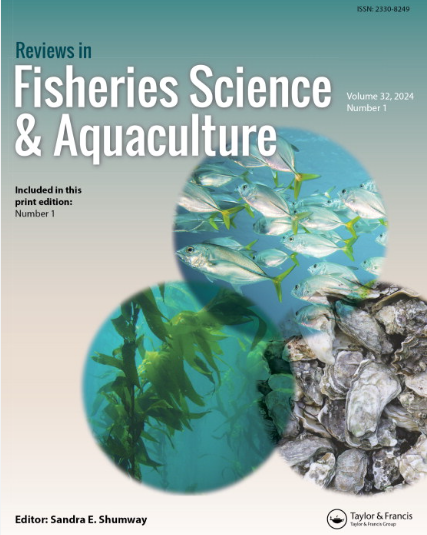斑马鱼作为研究炎症的工具:系统综述
IF 5.3
1区 农林科学
Q1 FISHERIES
引用次数: 2
摘要
摘要斑马鱼(Danio rerio,斑马鱼)是一种合适的动物模型,已被用于模拟各种疾病,如水产养殖相关的传染源和炎症过程。本研究综述了用于研究斑马鱼炎症的方法,以揭示其在炎症建模中的有用性。PubMed、Scopus、Web of Science和Lilacs数据库使用关键词“炎症”和“斑马鱼”搜索了截至2020年2月18日发表的原始研究文章。在确定的3001篇文章中,有60篇包含在本研究中。其中包括汇编用于诱导炎症的方法的文章,最常用的方法是尾鳍损伤和浸泡在炎症溶液中。此外,炎症细胞(巨噬细胞和中性粒细胞)的增加、细胞因子(TNF-α、IL-1β、IL-6和IL-8)和趋化因子(CXCL18-l1)水平的提高证实了该方法的有效性。这些结果证实,斑马鱼的炎症过程与其他动物物种的炎症过程相似,如鲶鱼和哺乳动物。因此,斑马鱼可以用于筛选新的抗炎剂,阐明炎症的途径和病理,也可以转化为其他鱼类,有助于预防鱼类疾病,对水产养殖经济产生积极影响。本文章由计算机程序翻译,如有差异,请以英文原文为准。
Zebrafish as a Tool for Studying Inflammation: A Systematic Review
Abstract Danio rerio (zebrafish) is a suitable animal model that has been used to model a wide range of diseases such as aquaculture-relevant infectious agents and inflammatory processes. This study reviewed methods employed to study inflammation in zebrafish to reveal its usefulness in modeling inflammation. PubMed, Scopus, Web of Science, and Lilacs databases were searched for original research articles published until February 18, 2020, using the keywords “inflammation” AND “zebrafish.” Of the 3001 articles identified, 60 were included in this study. These included articles that compiled the methods used to induce inflammation with the most frequently used methodologies being tail fin injury and immersion in inflammatory solution. Moreover, the effectiveness of the methodology was confirmed by the increase in inflammatory cells (macrophages and neutrophils), enhanced levels of cytokines (TNF-α, IL-1β, IL-6, and IL-8), and chemokines (CXCL18-l1). These results confirmed that inflammatory processes in zebrafish are similar to those in other animal species, such as catfish (Ictalurus punctatus) and mammals. Therefore, zebrafish can be used to screen new anti-inflammatory agents and elucidate the pathway and pathology of inflammation, which can also be translated to other fishes and help to prevent fish diseases, resulting in a positive impact on the aquaculture economy.
求助全文
通过发布文献求助,成功后即可免费获取论文全文。
去求助
来源期刊

Reviews in Fisheries Science & Aquaculture
FISHERIES-
CiteScore
25.20
自引率
0.90%
发文量
19
期刊介绍:
Reviews in Fisheries Science & Aquaculture provides an important forum for the publication of up-to-date reviews covering a broad range of subject areas including management, aquaculture, taxonomy, behavior, stock identification, genetics, nutrition, and physiology. Issues concerning finfish and aquatic invertebrates prized for their economic or recreational importance, their value as indicators of environmental health, or their natural beauty are addressed. An important resource that keeps you apprised of the latest changes in the field, each issue of Reviews in Fisheries Science & Aquaculture presents useful information to fisheries and aquaculture scientists in academia, state and federal natural resources agencies, and the private sector.
 求助内容:
求助内容: 应助结果提醒方式:
应助结果提醒方式:


